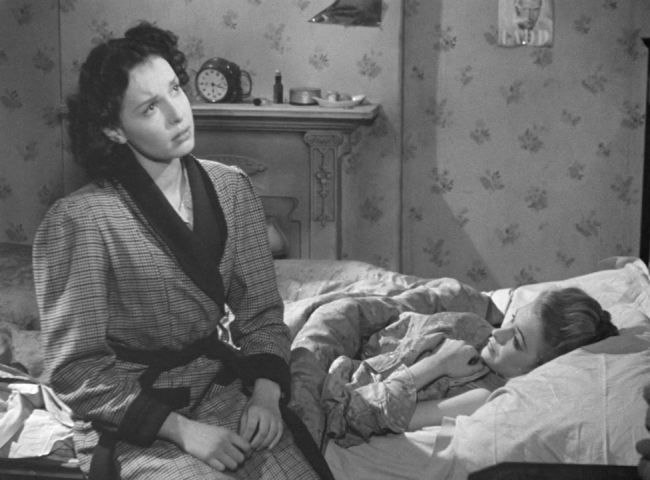
London's East End in the aftermath of World War II was not an easy place to live in. In addition to physical damage to structures from the war there was also a persisting scarcity of resources. The 1948 film noir It Always Rains On Sunday captures some of this world in an almost incidental way, featuring some real location footage but even more extraordinary backlot scenes populated by diverse characters, shot by the great cinematographer Douglas Slocombe. Featuring several curious subplots, the main story surprisingly focuses on women dealing with sexual frustration. The end abruptly crashes into a set of solutions to meet moral imperatives but the film is fascinating in the lead up to these especially since a few of the subplots, uniquely for films of the time, remain unresolved.

Googie Withers stars as Rose Sandigate, a young working class wife married to a man, as the dialogue pointedly draws attention to, twelve years her senior, George (Edward Chapman). Rose is constantly frustrated and argumentative but seems glumly settled down to life caring for the basically amiable George and his three children from a previous marriage--two beautiful teenage daughters, Vi (Susan Shaw) and Doris (Patricia Plunkett), and a little boy named Alfie (David Lines).

Like most teenage girls, Vi and Doris have their dramas involving boys, but Vi's trouble is slightly unusual. She's been going out with an older, married man--a band leader and owner of a music shop named Morry Hyams (Sydney Tafler).

The film features several unambiguously Jewish characters, unusual for the time, especially striking given the film's tangential relationship to World War II. We meet Morry's wife, Sadie (Betty Ann Davies), and his brother, Lou (John Slater), who runs a local arcade and seems to be something of a mild gang boss, though he never comes off as especially sinister or foolish. Three would-be gangsters who try to associate with him are played more for laughs. In one amusing scene, they show up at a store owner's home and try to force him to pay exorbitant rates for possibly stolen goods but the store owner manages to intimidate them a bit into lowering prices and securing a deal for paying on delivery. The three young men leave with slumped shoulders, like three Charlie Browns who've failed to start a protection racket.

The film's main plot starts when George casually mentions one of the guys who escaped from prison the night before is someone named Tommy Swann (John McCallum). Rose struggles to maintain composure, doesn't quite succeed, but the blissfully oblivious George doesn't notice. Tommy is a former lover of Rose's, from before she met George. When she discovers him hiding in the yard, we discover that Tommy is a lot younger a lot better looking than George.

She stashes the dirty, wide eyed, desperate hulk of a man in her upstairs bedroom, a walking and talking metaphor for her own repressed passion and sexuality. With the affable and stable but soft and sexless George as her husband, it's easy to draw comparisons to Madame Bovary, especially as Rose finds it more and more difficult to resist her attraction to Tommy.

Vi and Doris both resent having to call Rose mother--one wonders how far apart in age the girls are from Rose--and the tension between Rose and Vi starts to boil over when Vi tries to get into the room where Rose has hid Tommy in order to get a mirror Rose borrowed. There's a lot you could unpack there if you wanted to analyse--Vi intruding on the territory of Rose's hidden sexual desire and shame, the younger girl's mirror as a sign of self-reflection and a tool of beautifying oneself in the effort to attain sexual satisfaction. As Vi struggles with the locked door, the two get into an argument that turns into a slightly bizarre, more than slightly kinky fight where Rose rips Vi's dress in half.

Of course the film can't say much directly about sex but it's visually communicated in a lot of ways. Googie Withers never seems to be wearing a bra in the film, for one thing. With the vivid realism of the neighbourhood and the relationships between family members, and the realistic overlapping of frequently unresolved subplots, the film manages to make what it's not saying come across very distinctly.

No comments:
Post a Comment